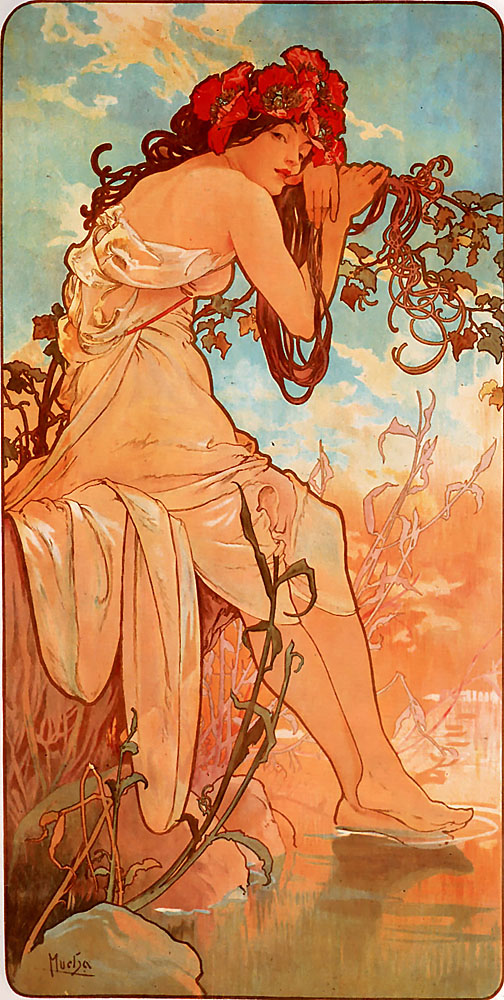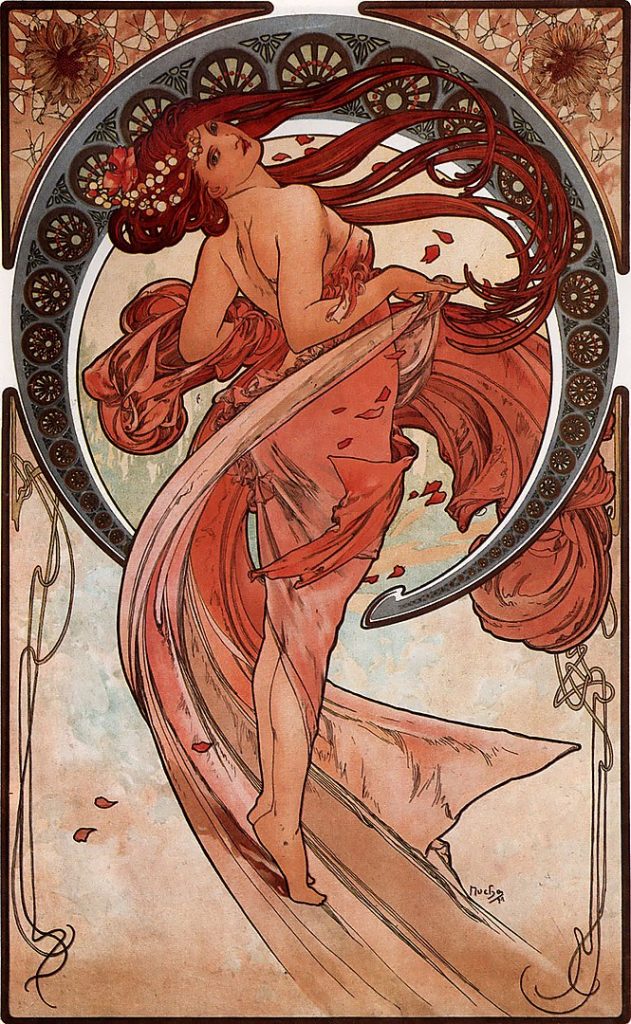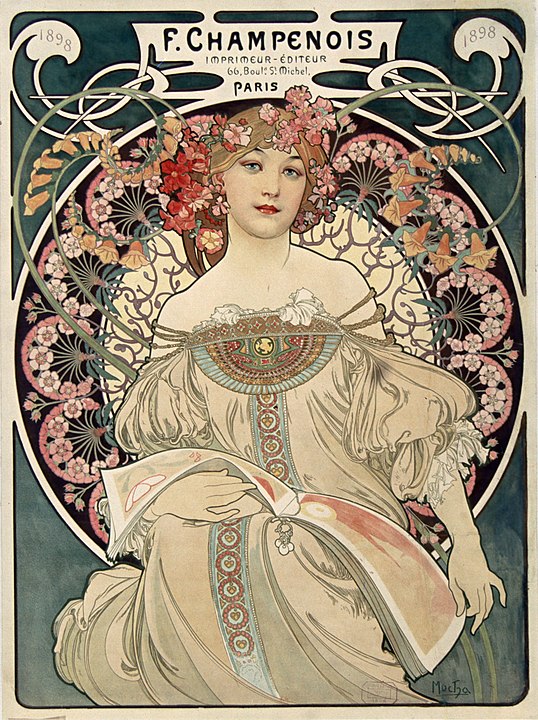Alphonse Mucha became a crucial character in the Art Nouveau style, representing a combination of profound cultural implications and exquisite aesthetic beauty. In addition to perfectly capturing the mood of his day, his magnificent illustrations and posters—which mainly featured idealised feminine figures—also established a distinctive style that emphasised the relationship between art and everyday life. Mucha’s influence and esteem endure, and his works celebrate the beauty of nature, femininity, and national creative identity. His legacy lives on in contemporary art.
The Continuing Impact of Alphonse Mucha
On July 24, 1860, Alphonse Mucha was born in Ivančice, Moravia, a part of the Austrian Empire, which is today the Czech Republic. He came to Vienna to pursue an apprenticeship in scenery painting after starting his artistic career in Brno. Mucha moved to Paris in the late 19th century, where he rose to fame for his avant-garde posters, particularly those made for the well-known actress Sarah Bernhardt6. Belle Époque art was a fusion of commercial art and creative research, and Mucha’s career prospered during this time, paving the way for the rise of the Art Nouveau style. Mucha created a distinct and organic style by incorporating elements from various sources, such as Japanese woodcuts, Hans Makart, and the Pre-Raphaelites. His emphasis on feminine beauty, flowing lines, and elaborate embellishments are characteristics of his work. He celebrated femininity as a counterweight to the industrialised and impersonal parts of modern life by portraying the “new woman” frequently. His famous “Mucha woman”—depicted with curves, flowing hair, and an almost ethereal appearance, expressing life and light—is the result of this devotion.
Mucha believed that beauty was something that was intimately connected to both nature and spirituality. His portfolio was dominated by striking young women covered in ornate patterns and floral motifs, which balanced the subject and the surroundings. His portrayals of women in his artwork frequently speak to themes of caring and appeal, emulating an ideal of beauty beyond simple aesthetics to elicit cultural and emotional ties. Mucha made a significant contribution to the art world by elevating the Art Nouveau movement to a prominent societal position. His decorative arts and posters broke down barriers by fusing creativity and commerce and transforming commonplace objects into works of art. His art is noteworthy for its aesthetic appeal and capacity to convey deeper themes of nationality, identity, and culture—particularly in light of Czech pride and ancestry.
Aesthetics and Style of Mucha
Exquisite ornate patterns and a vivid colour scheme, frequently drawn from nature, characterise Mucha’s aesthetic style. From the delicate flower decorations surrounding his subjects to the curved forms, his posters exhibit exacting attention to detail6. His designs’ seamless fusion of word and image epitomises the Art Nouveau philosophy, which saw beauty in the synthesis of forms and has had a lasting influence on advertising and graphic design. Later in his career, Mucha developed a more nationalist theme, culminating in the creation of the renowned “Slav Epic” series. Twenty massive murals that celebrated the Slavic people’s cultural legacy and hardships expounded on the nation’s history and essence. It was a powerful statement of pride and individuality, very different from the commercial works of art he was first recognised for. The pieces emphasise a style that values beauty and ancestry by fusing historical themes with allegorical figures.

The legacy of Mucha is multifaceted; he is regarded as a master of the Art Nouveau movement and an artist whose creations stood the test of time. Modern commercial art, graphic design, and contemporary illustrations that arouse nostalgia for the elegance and complexity of his style are all examples of his impact. Mucha’s art has garnered new attention after his death, and his creations are honoured in galleries and museums across the globe, demonstrating their enduring popularity.
Alphonse Mucha was a pivotal character in the Art Nouveau movement. His works are not just beautiful; they have a philosophical and emotional meaning that resonates with the human condition. His commitment to form and soul beauty motivates artists in all mediums. Mucha significantly contributed to art history and contemporary aesthetic discourse by addressing cultural identity and socioeconomic transformations by celebrating the female form. The way that beauty and meaning interact in his work reminds us of the ability of art to reverberate beyond time, altering perceptions and stimulating contemplation on the value of artistic expression and cultural legacy.
Art Nouveau and Alphonse Mucha
In the 1880s, Art Nouveau emerged as a response to the mid-19th century emphasis on history. It was an attempt to look at modern living forms, beauty, and embellishments rather than stick to the historicism of the Romantic era. Like Impressionism, Art Nouveau represented a revolt against conventional and classical art. The trend was influential in expanding into decorative and commercial arts and fine art. Well-known artists like Gustav Klimt and Alphonse Mucha entered the world of advertising, high fashion, and jewellery creation. The integration of all facets of design and art is what defines the style.
Everything could be considered art, and Mucha created everything from massive national paintings to stage sets and advertisements for champagne and beer. The acceptability of Art Nouveau, an international modern art movement by the general public, was proved in 1900 at the Paris World’s Fair. Alphonse Mucha made paintings and articulated his ideas about design and art in his book Documents Decoratif, which led to Nouveau paintings and commercial posters featuring his likeness. Furthermore, some writers regard him as the epitome of Art Nouveau, who established the guidelines and applied them in various contexts, from jewels to scene decorations, theatre posters, and soap opera advertisements.
At 34, Mucha achieved sudden success following seven years of arduous struggle. With a new printer, Champenois, eager to promote his work with postcards and panneaux—sets of four large images centred around a central theme (four seasons, four times of day, four flowers, etc.)—he began publishing graphics with Champenois by 1898. He had also moved to a new studio. As a result, the artist follows the great legacy of Art Nouveau by incorporating several domains that call for ornamentation and are symbols of how the world is changing, opportunities are opening up, and the boundaries of what art may express. Painting became more than just sketching pictures; it also involved visiting new places.

Mucha was well-known; as soon as the artist created them, his posters and other decorations sold out. In addition, Mucha was assigned work because people were aware of his style, liked it, and wanted to see more of his work. The product to be advertised was, in fact, present in the poster—a piece of a bicycle in round shapes emerging from a young girl’s hair. In this instance, the advertised product comes in second after the artist explains that Mucha was using the soap as a vehicle for his artistic expression and beauty rather than the soap as the object of his creative endeavours. In summary, he represented the extreme rather than the average, which contrasts sharply with the modern advertising landscape. This is another example of how, despite their commercial production, the posters were, first and foremost, artistic creations, valuable for the imagination of the writer who brought them to life rather than for conveying the distinctive qualities of the marketed goods.
Mucha produced over 100 posters and ornamental panels and is still regarded as a superb lithographer and colourist today. His piece of work is still appreciated and valued today. His posters have traversed the world in unique displays. His renown grew internationally, and many visits to the United States produced illustrations and covers for American periodicals. Additionally, American clients commissioned portraits. He was ready to start what he saw as his life’s work by the conclusion of the decade.
Alphonse Mucha: In Quest of Beauty
In much of the study around the work of Czech artist Alfons Maria Mucha (1860–1939), the seductive, sensual female fatales that grace his pictures have played a prominent role, especially following the art nouveau renaissance in the late 1960s. Following many years of obscurity, San Francisco artists started using Mucha’s femme fatales in their psychedelic movement-related prints. Coincidentally, the psychedelic movement coincided with a shifting terrain for feminist movements, which may reflect societal changes that reshaped conceptions of femininity during the Belle Époque.

The shifting representation of femininity in the paintings of the Pre-Raphaelites and the works of art nouveau artists like Mucha may be seen in these transient pieces. Among the numerous accounts of Mucha’s work that are examined in Alphonse Mucha: In Quest of Beauty (many of which are included in this catalogue for an exhibition in the style of a retrospective), I will concentrate here on how the book covers the culture of shifting femininity during Mucha’s lifetime, who was involved in these shifts, examples of how these shifts have been depicted artistically, and so forth; hopefully commenting Mucha’s place in these discussions in the process.
We may observe how women were shown as repressed to demonstrate the male artists’ manhood, starting with the Pre-Raphaelite Brotherhood. They would go so far as to deprive their model of her humanity and reduce her to the status of a symbol or an object. Two of its most well-known artists, the Macdonald sisters, attended the Glasgow School, which was located on the other side. The school promoted equal access to education for all students, irrespective of gender, class, or background. Despite this, they continued to experience criticism and, as a result of their gender, felt dominated by their husbands. Depending on the image, Mucha is positioned in the centre. Her portrayals of women were occasionally focused on a more important goal, such as harmonious national unity, but they were still vulnerable to the male gaze.
Sato could discern differences between Mucha’s artwork and his contemporaries, at least in some instances, by incorporating his less well-known theoretical concepts. His images diverge from those of the Brotherhood and other art nouveau artists who adhered to aestheticism or the notion of “art for art’s sake” because of his commitment to developing theoretical conceptions of beauty. He pursued his “Quest of Beauty” for more than aesthetics.





